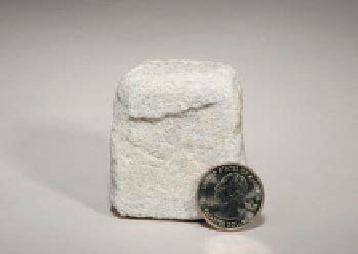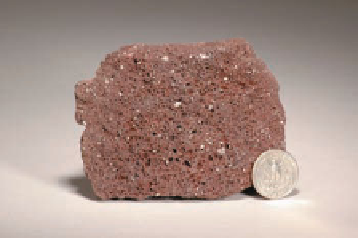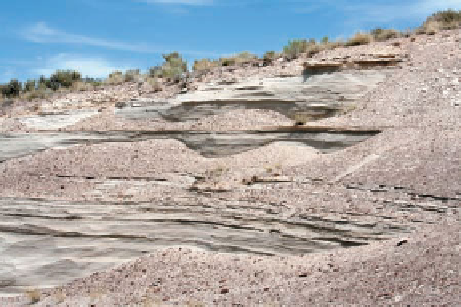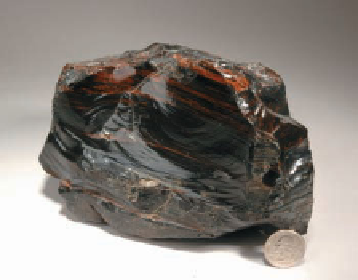Geology Reference
In-Depth Information
?
cools and crystallizes within Earth's crust (see Geo-inSight
on pages 100 and 101). We can observe these rock bodies
only when uplift and deep erosion have taken place, thereby
exposing them at the surface. Furthermore, geologists can-
not duplicate the conditions under which intrusive rocks
form except in small laboratory experiments.
Geologists recognize several types of plutons based on
their geometry (three-dimensional shape) and relationships
to the country rocks. In terms of their geometry, plutons
are tabular, cylindrical, or irregular (massive). Furthermore,
they may be
concordant
, meaning they have boundaries that
parallel the layering in the country rock, or
discordant
, with
boundaries that cut across the country rock's layering (see
Geo-inSight on pages 100 and 101).
What Would You Do
As the only member of your community with any geology
background, you are considered the local expert on minerals
and rocks. Suppose one of your friends brings you a rock
specimen with the following features—composition: mostly
potassium feldspar and plagioclase feldspar with about
10% quartz and minor amounts of biotite; texture: minerals
average 3 mm across, but several potassium feldspars are up
to 3 cm. Give the specimen a rock name and tell your friend
as much as you can about the rock's history. Why are the
minerals so large?
Dikes
and
sills
are tabular or sheetlike igneous bodies that
differ only in that dikes are discordant and sills are con-
cordant. Dikes are quite common and range from a few
centimeters to more than 100 m thick. Invariably, they are
intruded into preexisting fractures or where fl uid pressure
is great enough for them to form their own fractures as they
move upward into county rock. Erosion of the Hawaiian
volcanoes exposes dikes in fracture zones, and the Colum-
bia River basalts in Washington State (see Chapter 5) issued
from long fi ssures in which magma solidifi ed to form dikes.
Dikes underlie the Laki fi ssure and Eldgja fi ssure in Iceland,
both of which have been the sites of voluminous eruptions
during the past 1000 years.
Sills are tabular just as dikes are, but they are concordant.
Many sills are a meter or less thick, although some are much
thicker. A well-known sill in the United States is the Palisades sill
that forms the Palisades along the west side of the Hudson River
in New York and New Jersey (see Figure 22.7d). This 300 m-
thick sill is exposed for 60 km along the river. Most sills were
intruded into sedimentary rocks, but eroded volcanoes also
reveal that sills are injected into piles of volcanic rocks. In fact,
some of the inflation of a volcano that precedes an eruption
may be caused by the injection of sills (see Chapter 5). In con-
trast to dikes, which follow zones of weakness, sills are intruded
between layers in country rock when the fl uid pressure is great
enough for the magma to actually lift the overlying rocks.
Under some circumstances, a sill infl ates and causes the
overlying rocks to bow upward, forming an igneous body
called a
laccolith
. A laccolith
has a flat floor and is domed
up in its central part, giving it a
mushroom-like geometry (see
Geo-inSight on pages 100 and
101). Like sills, laccoliths are
rather shallow intrusions that
lift the overlying rocks. Well-
known laccoliths in the United
States are in the Henry Moun-
tains of southeastern Utah, and
several buttes in Montana are
eroded laccoliths.
◗
Figure 4.17
Igneous Rocks Classifi ed Primarily by
Their Texture
a
Tuff is made up of pyroclastic materials such as those
shown in Figure 4.9g.
b
The natural glass obsidian.
d
Scoria is also vesicular, but it is darker,
denser, and more crystalline than pumice.
c
Pumice is glassy and extremely vesicular.









Search WWH ::

Custom Search